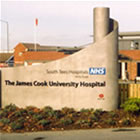
|
July 28, 2009 -- For patients having the most serious form of heart attack, a new study from the United Kingdom concludes that primary angioplasty performed from the wrist "is safe, with comparable outcomes to a femoral approach and a lower risk of vascular complications."
Patients with cardiogenic shock were excluded from this study, since most would require placement of an intra-aortic balloon pump, which is done through the femoral artery. A number of recent studies and reports have documented the advantages of the wrist approach, yet it is utilized in less than 5% of cases in the U.S. A common concern, primarily among cardiologists who practice the femoral approach from the groin, is that radial access may take longer, or may not be possible in some patients, requiring cross-over to the femoral approach -- something that might impact patient safety when time is of the essence, as in treating acute myocardial infarction. In this study, even though the cross-over rate from radial to femoral was 7.7%, as opposed to 0.6% for femoral to radial, there was no difference in in-hospital mortality or MACE between the two cohorts. However, those patients where wrist access was used had no major vascular complications (almost 2% for femoral) -- and many of these were bleeding complications requiring transfusion, a situation associated with increased mortality at 30 days and one year (see the M.O.R.T.A.L. study). Further advantages for the radial side were an average of one less day of hospital stay for the radial patients and therefore lower cost -- a factor which has significant implications in the current healthcare environment in the United States. One interesting sidelight: the use of the radial technique increased over the four year observational period due to operators who primarily started with the femoral tecnique changing over more and more to the radial technique. This migration is reported by a number of interventional cardiologists who, once past the learning curve, find that they do almost all of their cases via the wrist. Reported by Burt Cohen, July 28, 2009 |

